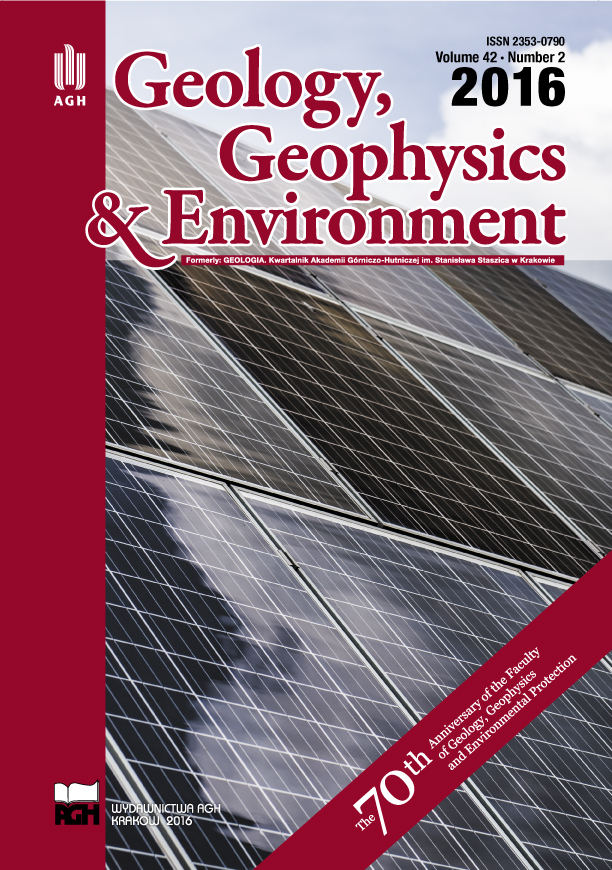The influence of technogenic factors on the karst activization of Precarpathian salt sediments and karst natural lows
DOI:
https://doi.org/10.7494/geol.2016.42.2.175Keywords:
salt karst, gypsum-clay cap, Miocene salts, Precarpathians, potash salt miningAbstract
The purpose of this article is to conduct an analysis of the technological and natural factors that have influenced the development and intensification of the salt karst, located within Miocene salt-bearing sediments. Understanding the rules of the karst process is one way to help make the right decisions at the forecasting stage of these harmful exogenic geological processes. This is especially true of salt deposits, which are located in complex geological conditions (e.g. the Carpathian Foredeep). The development of the salt karst in the Precarpathian has shown that it is a complex multi-system process, where all the components have a significant impact on the results and they are directly related to each other. The results of the completed research confirm that the features of the spatial development of the karst processes within the Carpathian salt deposits are caused by the complex geological structures of the Miocene sediments. The spatial developments of the karst processes depend on the heterogeneity of the water penetration in the plans and sections of the salt-bearing deposits. This forms the predominant vector of the underground leaching intensity along the geological boundaries. Permeability and solubility of the salt bearing deposits along the bedding are higher, relative to the permeability and solubility across geological structures. Faults which occur across the strike of geological layers act as a containment of the karst processes along the geological borders.Downloads
References
Apsse R.F., Voronova L.B., Kozlov S.S. et al., 1966. Otchet po rezul’tatam gidrogeologicheskikh issledovaniy na uchastke techi v shtreke 43/2 rudnika No 1 Stebnitskogo kaliynogo kombinata. Fondy Stebnitskogo kaliynogo zavoda, Leningrad.
Blajda R. & Górecki J., 2001. Wpływ czynników litologiczno-strukturalnych na rozwój krasu solnego w złożu kopalni soli „Wieliczka”. Geologia: kwartalnik Akademii Górniczo-Hutniczej im. Stanisława Staszica w Krakowie, 27, 2–4, 329–340.
Bukowski K. & Czapowski G., 2009. Salt geology and mining traditions: Kalush and Stebnyk mines (Fore-Carpathian region, Ukraine). Geoturystyka, 3, 18, 27–34.
Frumkin A., 2013. Salt Karst [in:] Treatise on Geomorphology. Vol. 6: Karst Geomorphology, Academic Press, 208–424.
Gaydin A.M., 2008. Vliyaniye tekhnogennoy deyatel’nosti na solyanoy karst. Ekolohiya i pryrodokorystuvannya, 11, 42–54.
Lipnitskiy V.K., 1979. Geologo-gidrogeologicheskiye usloviya proryva vod v kameru 115/1 rudnika No 2 Stkz . Fondy Stebnitskogo kaliynogo zavoda, Leningrad.
Korotkevich G.V., 1970. Solyanoy karst. Nedra, Leningrad.
Pavliuk V., 2010a. Vplyv pryrodno-tekhnohennykh faktoriv na formuvannya ekoloho-heolohichnykh umov v Peredkarpatti (na prykladi rodovyshcha kaliynykh soley “Stebnyk”). Stroitel’stvo i tehnogennaja bezopasnost’: sbornik nauchnyh trudov, 33–34, 256–265.
Pavliuk V., 2010b. Vplyv heolohichnykh faktoriv na ekzohenni protsesy miotsenovykh solenosnykh vidkladiv Ukrayinskoho Peredkarpattya. Heolohiya i heokhimiya horyuchykh kopalyn, 2 (151), 89–104.
Stupnitskiy V.M., Zheksimbayev Yu.M., Fedchenko A.I. et al., 1995. Otchet po pereotsenke zapasov kaliynykh soley Stebnitskogo mestorozhdeniya L’vovskoy oblasti. L’vіvs’ka GRE, 4174, L’viv
Vakhromeeva V.A., 1959. Treshchynovatost’ solyanikh porod karnalytovoy zoni Verkhnekamskoho mestorozhdenyya. Trudy Vsesoyuznogo Instituta Galurgii, 35, 53–70.
Wolkersdorfer Ch., 2008. Water Management at Abandoned Flooded Underground Mines. Springer.
Downloads
Published
Issue
Section
License
Authors have full copyright and property rights to their work. Their copyrights to store the work, duplicate it in printing (as well as in the form of a digital CD recording), to make it available in the digital form, on the Internet and putting into circulation multiplied copies of the work worldwide are unlimited.
The content of the journal is freely available according to the Creative Commons License Attribution 4.0 International (CC BY 4.0)










